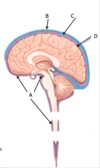1.9: The Eye and Raised ICP Flashcards
What is raised ICP? Types?
This is raised pressure in the cranial cavity Chronic or acute
Causes of raised ICP?
Increased pressure in fluid around brain (CSF) or increased pressure within brain itself
- Brain Tumour
- Head injury
- Hydrocephalus
- Meningitis
- Stroke
Is raised ICP a medical emergency? If yes, why?
Yes Because it can cause damage to the brain, spinal cord and the eyes
Describe the components of ICP?
ICP is the sum of:
- Blood
- Brain
- CSF
Describe how the ICP is kept constant?
If one component increases, the others decrease to compensate and keep the ICP constant (and vice versa)
Describe the monro-kellie hypothesis?
If one component of ICP increases, the others decrease the compensate and keep the ICP constant (and vice versa)
Describe the cranial cavity in regards to ICP?
The cranial cavity is an enclosed space and is unable to expand as the pressure increases
Describe the relationship between ICP and volume?
As volume increases, compensatory mechanisms are able to prevent the pressure from rising After compensatory mechanism fail, a small change in volume will cause a large change in pressure (exponential)
Increased pressure can lead to damage Give examples?
Damage to tissue
Shifts to tissue
Damage to brain, spinal cord and eye
Herniation
Constriction of blood vessels
Describe a statistic that links raised ICP and visual symptoms?
65% of patients with ICP will complain of some visual symptoms
Examples of visual symptoms caused by raised ICP?
Transient Blurred Vision Doubled Vision Loss of Vision Papilloedema (Swelling of optic discs due to raised ICP) Pupillary changes Can affect one eye or both
Optic nerves are not actually nerves but they are…?
CNS Tracts
What covers optic nerves?
3 Meninges: - Dura - Arachnoid - Pia
What is the space between the Arachnoid and Pia called?
Sub-arachnoid space
What are meninges?
These are the three membranes than envelope the brain and the spinal cord - they are the protective coverings




